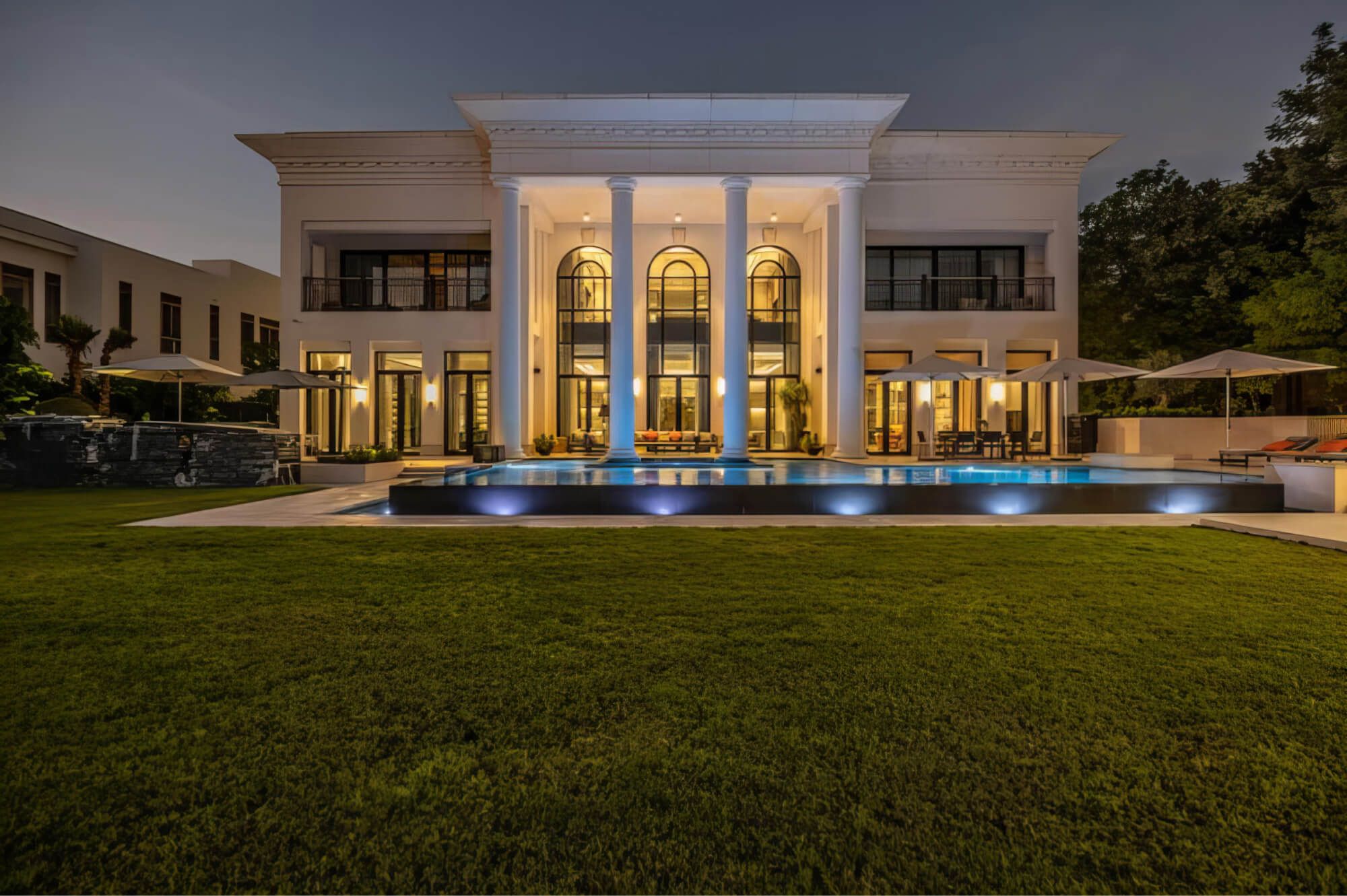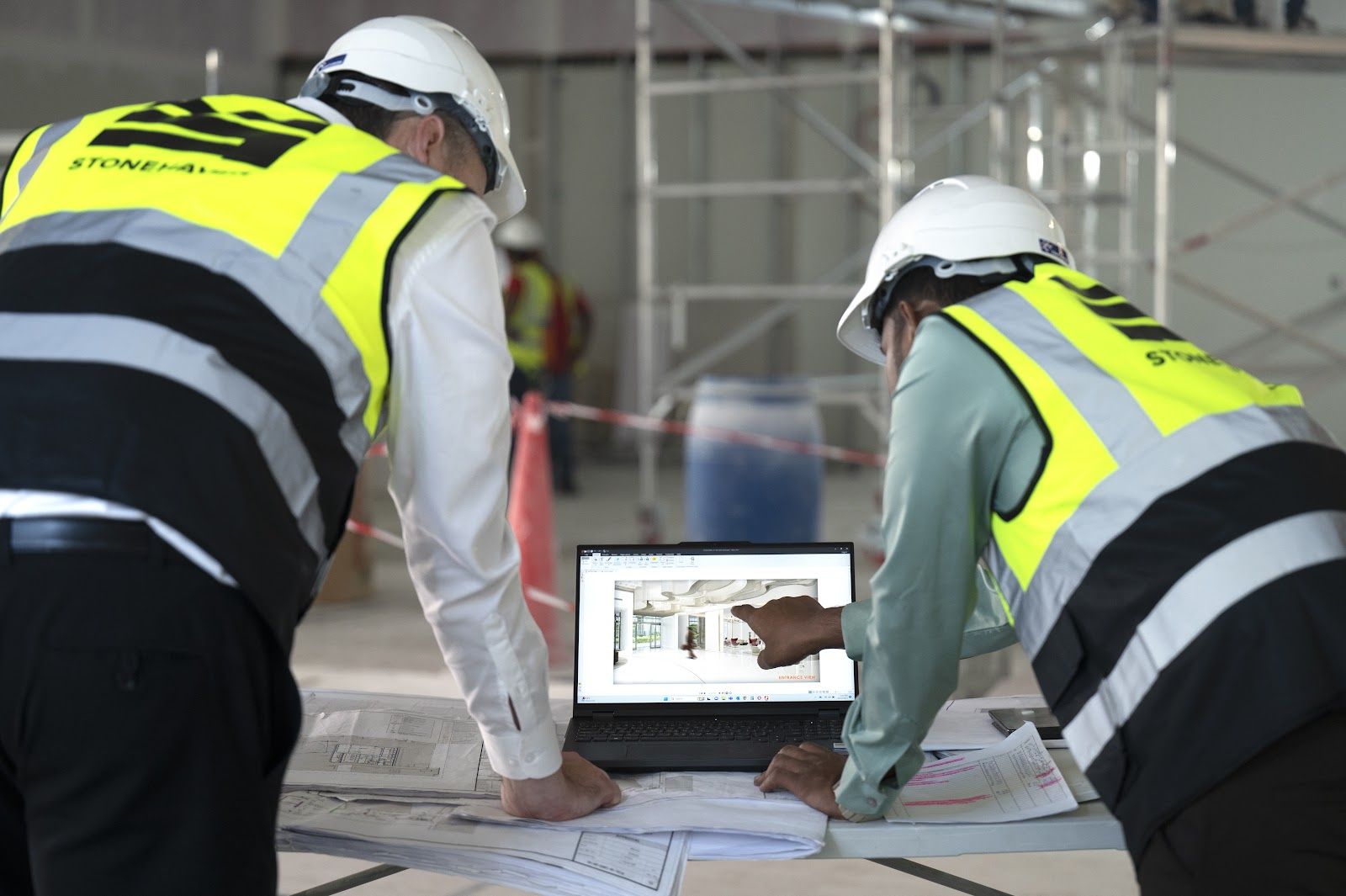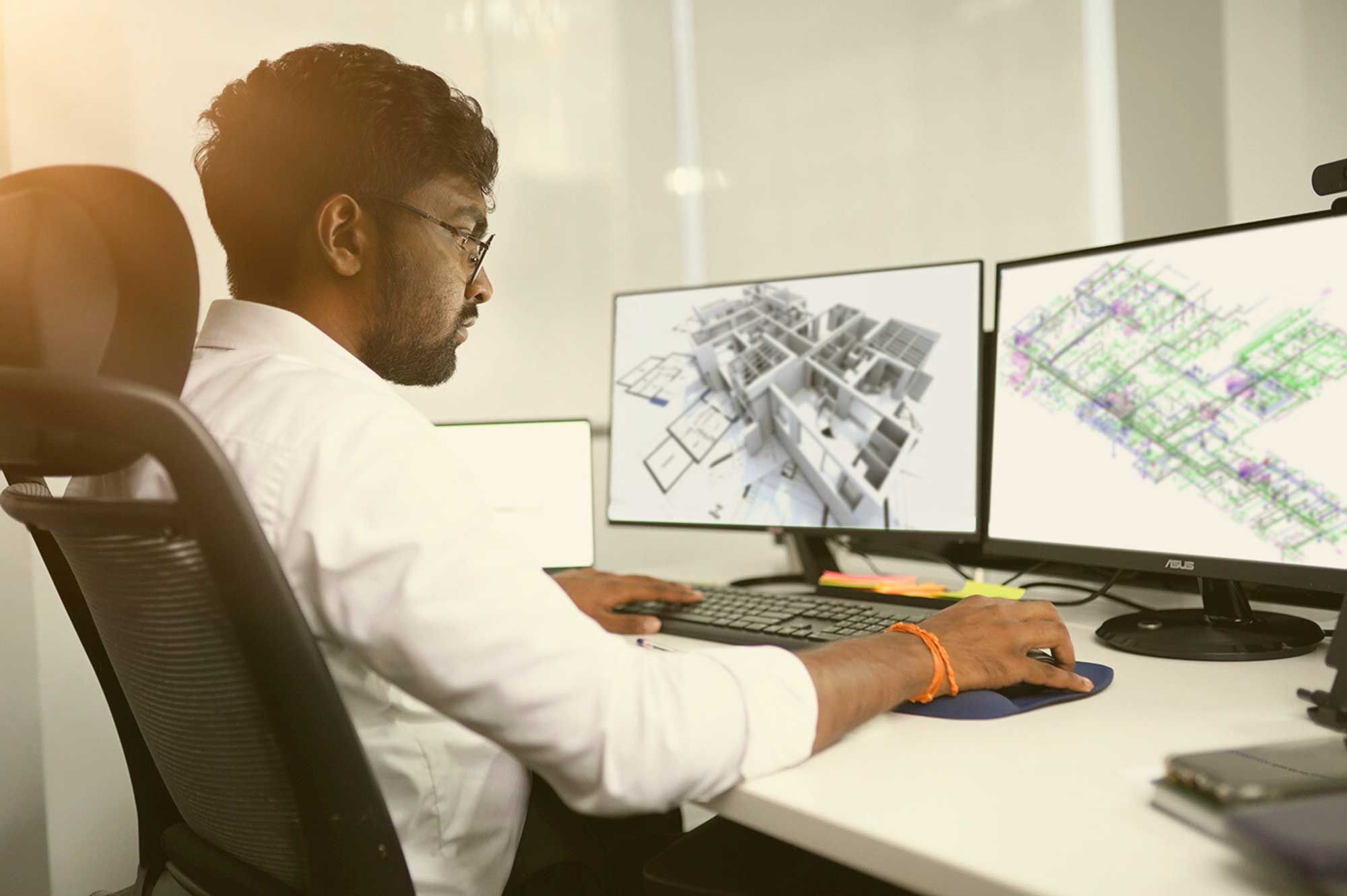Residential construction demands a high level of precision and collaboration among different disciplines to create homes that meet modern needs for comfort, functionality, and sustainability. Among these disciplines, MEP engineering (Mechanical, Electrical, and Plumbing) is critical. MEP systems form the backbone of residential buildings, ensuring they are liveable, energy-efficient, and safe.
From energy optimisation to water management and smart home integration, MEP engineers play an essential role in making homes future ready. The integration of these systems must be seamless to ensure they work together to provide a functional and efficient living space. Whether it’s regulating indoor climate through HVAC systems, supplying power safely, or managing water resources effectively, MEP systems touch every aspect of a home’s functionality.
This blog explores the various types of MEP systems, their critical responsibilities, the requirements for implementation, and the benefits they provide in residential construction. Whether you’re a homeowner, a builder, or a developer, understanding the role of MEP engineering is crucial in creating modern, efficient, and resilient homes.
What are the Types of MEP Systems in Residential Construction?
In residential construction, Mechanical, Electrical, and Plumbing (MEP) systems are pivotal, often constituting up to 25% of the total construction budget. This significant investment underscores the critical role MEP engineering plays in ensuring homes are liveable, energy-efficient, and safe.
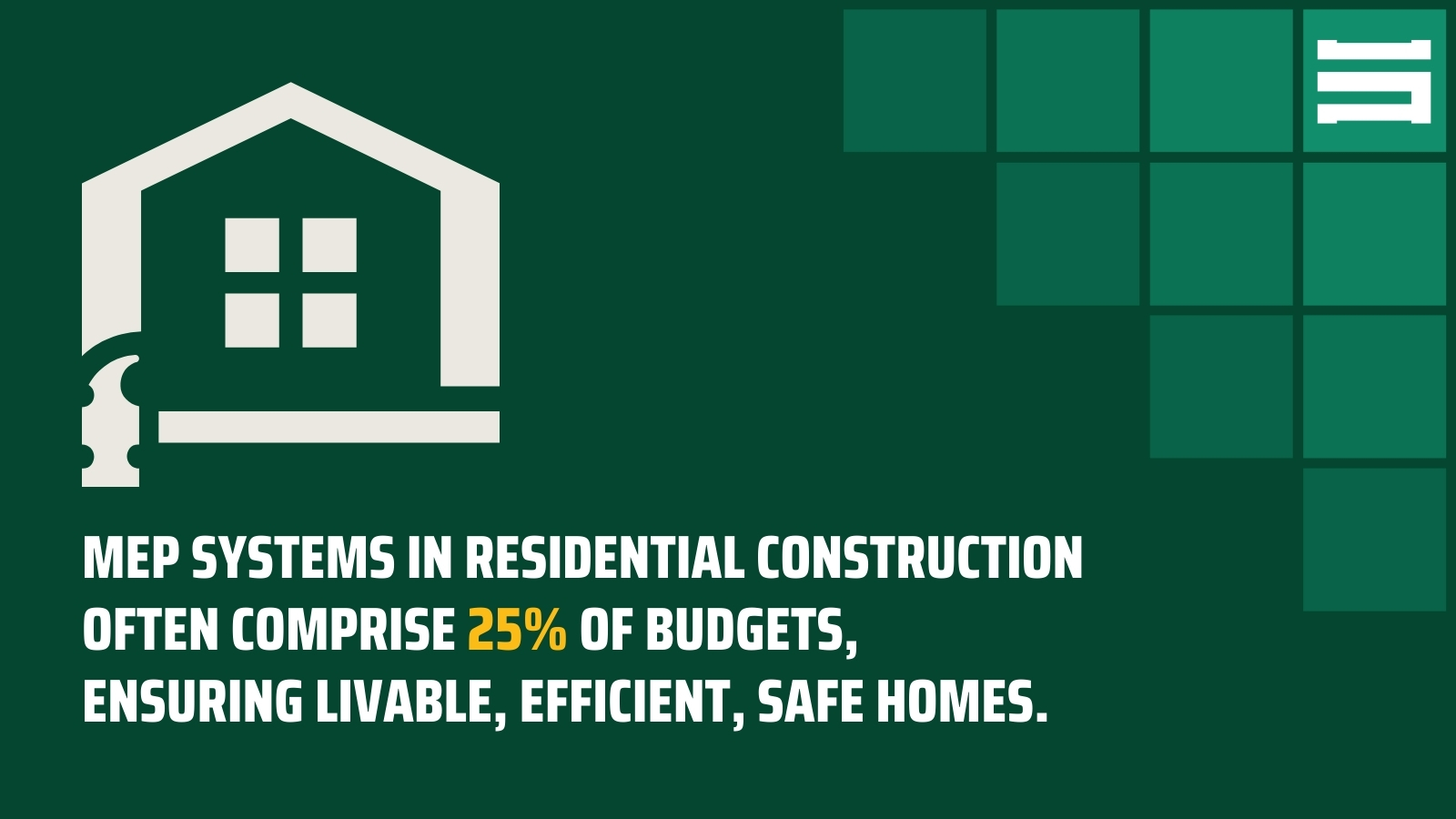
MEP systems are categorised into three core disciplines—mechanical, electrical, and plumbing—each designed to serve critical functions in residential construction:
1. Mechanical Systems
MEP engineering focuses primarily on HVAC (Heating, Ventilation, and Air Conditioning) systems. These systems are responsible for regulating indoor temperatures, ensuring proper air circulation, and maintaining good air quality. With the advent of energy-efficient solutions such as geothermal heating, heat recovery ventilators, and VRF systems, HVAC systems have become more sustainable and cost-effective. Modern systems also include smart thermostats, which allow homeowners to monitor and control temperature remotely.
2. Electrical Systems
Electrical support involves the safe distribution of power throughout a building. This includes designing layouts for lighting, power outlets, and renewable energy systems like rooftop solar panels. With the rise of energy-efficient lighting solutions such as LED fixtures and advanced energy management systems, residential electrical designs focus on minimising energy consumption while maintaining functionality. Smart home integration has become a standard feature in many residential projects, enhancing convenience and reducing energy waste.
3. Plumbing Systems
Plumbing ensures a safe and efficient water supply, drainage, and sewage system. Key advancements in residential plumbing include water-saving fixtures, greywater recycling systems, and rainwater harvesting systems. These not only promote water conservation but also help homeowners save on water bills. Proper plumbing design also ensures that systems are durable and leak-free, reducing the need for frequent repairs.
Each of these systems plays a crucial role in ensuring that a residential space is functional, efficient, and sustainable. Effective integration of mechanical, electrical, and plumbing systems by residential MEP engineers is key to creating modern living environments.
What are the Responsibilities of MEP Engineers in Residential Projects?
The role of an MEP engineer in residential construction is multifaceted, encompassing everything from design and implementation to quality control and post-construction support. These responsibilities ensure that the systems installed are functional, compliant with regulations, and built to last.
1. Comprehensive System Design
MEP engineers begin by designing detailed systems for HVAC, electrical wiring, and plumbing, ensuring they align with architectural and structural plans. Tools like Building Information Modelling (BIM) enable engineers to create 3D designs, detect potential clashes between systems, and optimise space usage. This is especially critical in residential projects where space is often limited.
2. Optimising Energy Efficiency
A significant responsibility of MEP engineers is identifying opportunities to reduce energy consumption. This includes selecting energy-efficient HVAC units, integrating solar energy systems, and designing layouts for LED lighting. These measures help homeowners reduce utility bills while contributing to sustainability goals.
3. Collaboration with Contractors and Architects
Collaboration is essential for MEP engineers to ensure systems integrate seamlessly into the construction project. They work closely with architects, contractors, and project managers to avoid design conflicts and ensure smooth execution.
4. Quality Assurance and Follow-up
MEP engineers supervise the installation of systems to ensure compliance with design specifications and quality standards. Quality assurance prevents costly rework and guarantees that the systems function optimally.
5. Post-Construction Maintenance
Post-construction, MEP engineers provide support to troubleshoot and maintain systems. This ensures systems remain efficient and durable over the long term.
From initial planning to maintenance, the work of an MEP engineer ensures that residential systems are functional, safe, and future proof.
How Much Does MEP Engineering Cost in Residential Projects?
The cost of MEP engineering services in residential construction varies significantly depending on a range of factors, each playing a critical role in shaping the overall budget. While these costs may seem substantial at first, they ultimately contribute to creating efficient, sustainable, and high-performing homes that yield long-term savings.
Factors Influencing MEP Engineering Costs
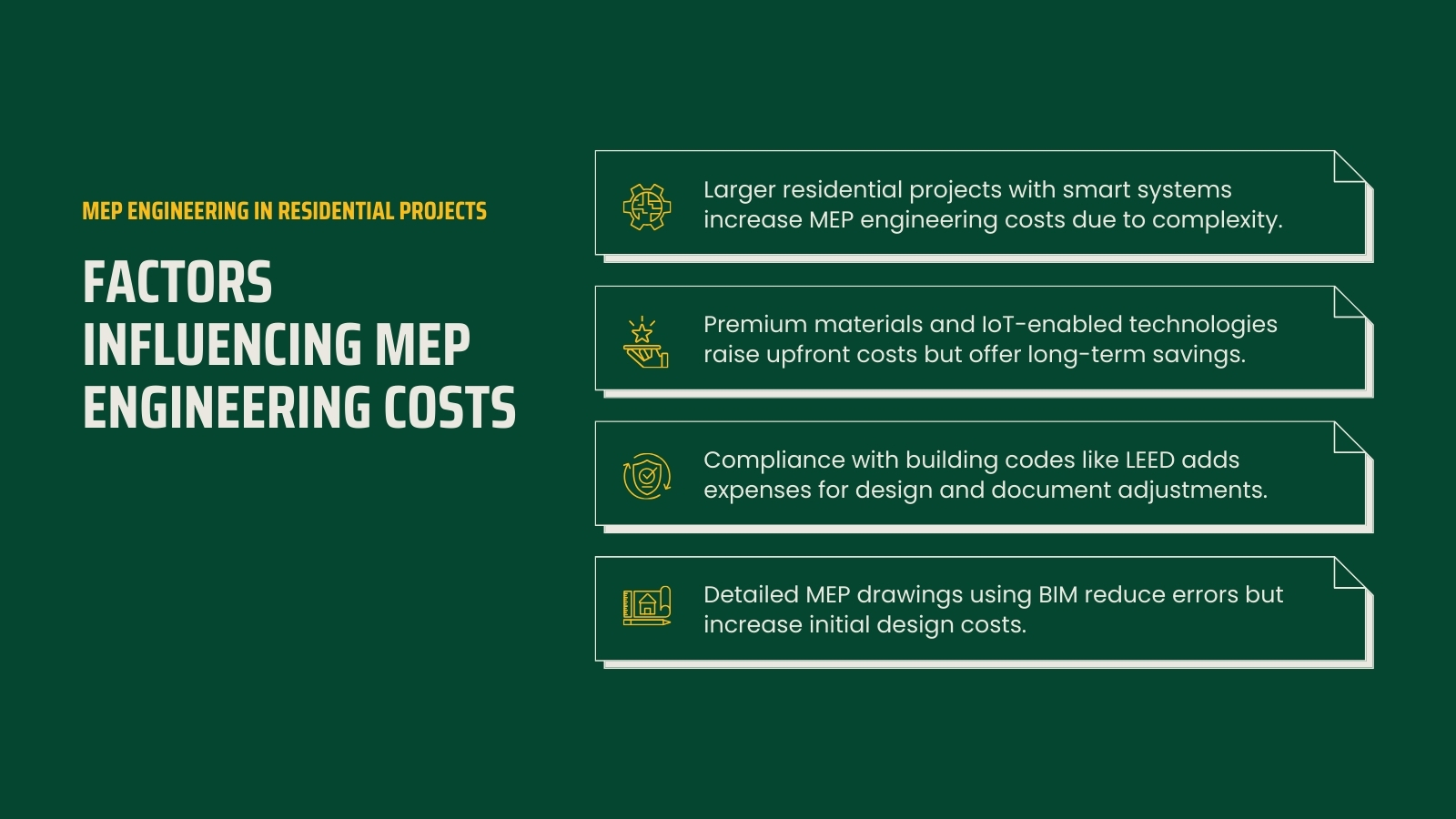
- Project Size and Complexity: The size and complexity of a residential project directly influence the cost of MEP engineering. For smaller homes with standard requirements, costs are typically lower due to fewer systems and straightforward designs. However, larger residential developments, multi-unit housing complexes, or luxury homes with complex features such as smart home integration, advanced HVAC zoning, or renewable energy installations, will incur higher costs. For example, projects that include features like automated lighting, multi-zone climate control, or greywater recycling systems demand more intricate planning and execution.
- Materials and Technologies: The type of materials and technologies used in MEP systems can significantly impact the budget. Projects incorporating IoT-enabled devices, premium materials for durability, or renewable energy solutions like solar panels and geothermal heating systems tend to have higher upfront costs. However, these investments often pay off through reduced utility bills, lower maintenance requirements, and an increased property value.
- Regulatory Compliance: Meeting local building codes and regulations can add to the overall cost of MEP engineering. For instance, compliance with energy codes like green certification standards such as LEED or BREEAM may require additional design adjustments, documentation, and inspections, all of which incur additional expenses.
- MEP Drawings Cost: The preparation of detailed MEP drawings using advanced tools like Building Information Modelling (BIM) software is another cost consideration. While BIM tools enable precise designs and prevent costly on-site adjustments by detecting clashes between systems during the planning phase, the expertise required to produce these 3D models can raise the initial budget. However, they often lead to cost savings during construction by ensuring accuracy.
How To Manage MEP Engineering Costs
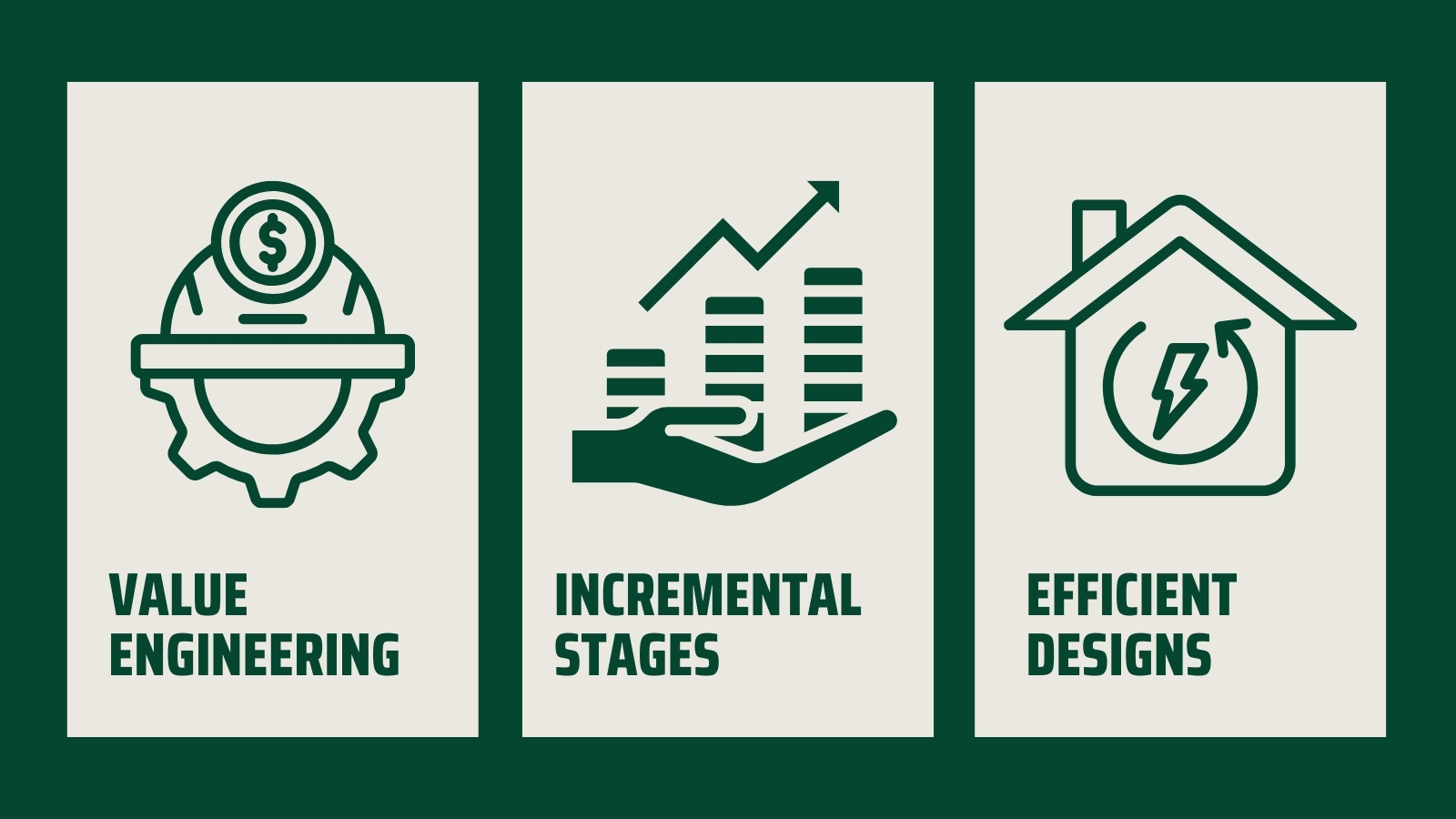
- Value Engineering
A common approach to managing costs is value engineering, where MEP engineers identify cost-effective alternatives to achieve the same performance. For instance, replacing high-cost materials with equally durable yet budget-friendly options or simplifying duct layouts without sacrificing efficiency. - Incremental Implementation
For homeowners with budget constraints, implementing MEP systems in phases can help spread costs over time. For example, starting with essential HVAC systems and later upgrading to smart technologies or renewable energy solutions. - Energy-Efficient Designs
Investing in energy-efficient systems like high-efficiency HVAC units or low-flow plumbing fixtures reduces operational costs in the long run, justifying the higher upfront expense.
What are the Common Scenarios Impacting MEP Costs in Residential Projects?
- Standard Residential Homes: A small family home with standard HVAC, electrical, and plumbing systems will generally have lower costs due to simplicity and fewer components.
- Smart Homes: Residences with integrated IoT technologies, such as smart thermostats, lighting controls, and automated water management, will have higher costs due to additional system design and installation requirements.
- Eco-Friendly Homes: Homes prioritising sustainability through solar panels, rainwater harvesting, or advanced insulation require greater upfront investment but benefit from reduced energy and water bills over time.
- Multi-Unit Housing: Larger-scale residential projects like apartments or housing developments often benefit from economies of scale, reducing the per-unit cost of MEP systems despite the overall project size being larger.
Challenges and Solutions in Residential MEP Engineering
- Space Constraints: Residential buildings often have limited space for installing MEP systems. To address this, MEP engineers use compact designs, such as slimline ductwork and concealed wiring. Tools like BIM further help in visualising layouts and optimising space.
- Balancing Costs and Quality: Budget constraints are common in residential projects. MEP engineers balance affordability with quality by using cost-effective yet durable materials and prioritising energy-efficient systems that provide long-term savings.
- Regulatory Compliance: Navigating the maze of building codes and safety standards can be challenging. Staying updated on changing regulations and designing systems accordingly ensures compliance and prevents legal issues.
- Integration of Advanced Technologies: Keeping up with the rapid evolution of smart and sustainable technologies is essential. MEP engineers continuously update their skill sets and adopt innovative solutions, such as IoT-enabled HVAC systems and renewable energy sources.
- Coordination with Stakeholders: Miscommunication among teams can lead to delays or design conflicts. Effective communication and detailed planning mitigate this challenge, ensuring timely project completion.
By addressing these challenges head-on, MEP engineers are redefining the standards of residential construction with innovative and efficient solutions.
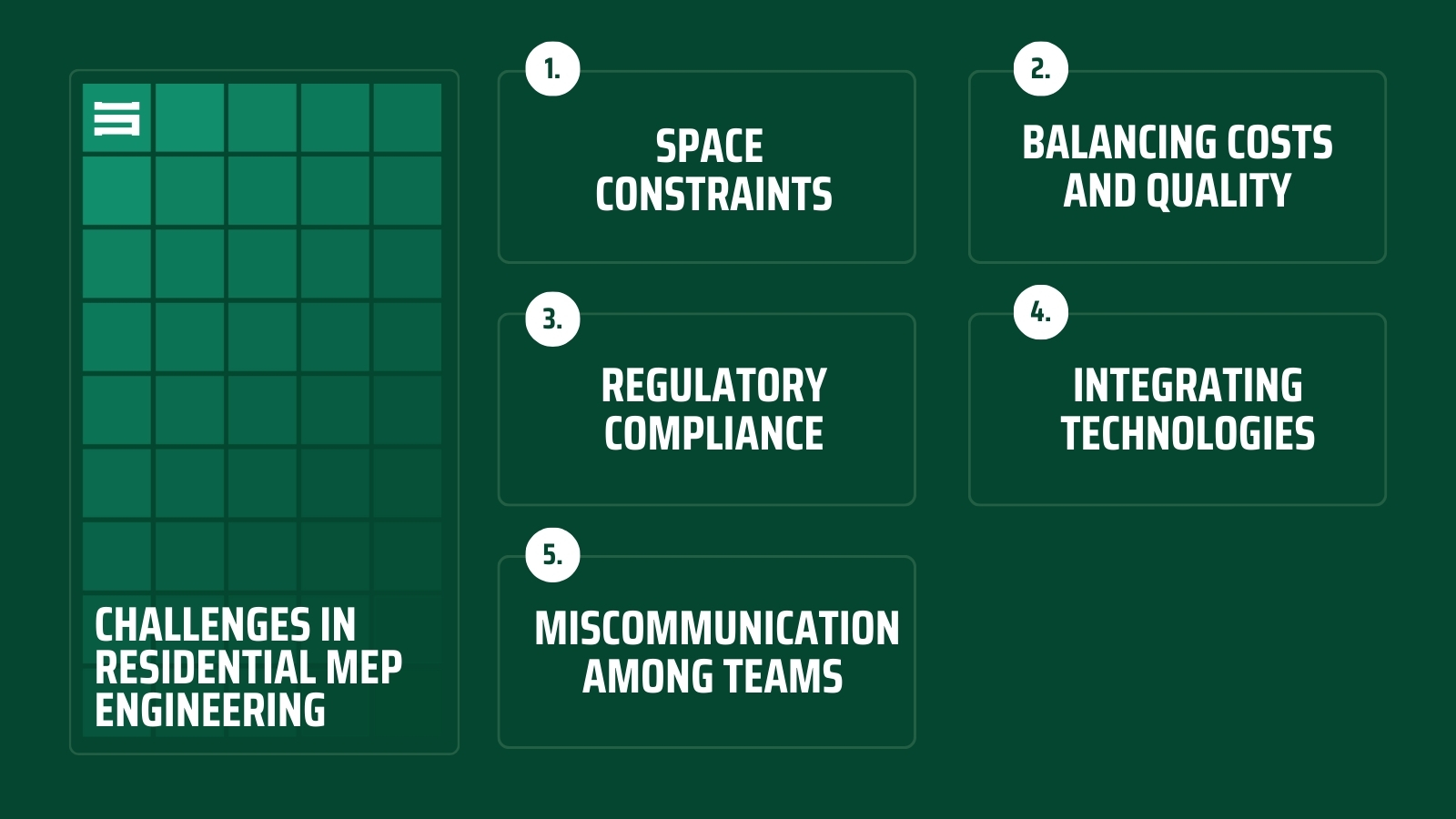
Sustainability and Smart Solutions in MEP Engineering
Sustainable Development Goals For Residences
Sustainability is no longer a luxury but a necessity in residential construction. MEP engineers contribute by incorporating renewable energy sources, such as solar panels, has become a cornerstone of sustainable residential MEP engineering. These systems not only provide clean energy but also reduce reliance on traditional power grids, lowering energy costs and carbon emissions.
Additionally, plumbing systems are being designed with a focus on water conservation with innovative solutions like water-saving fixtures, greywater recycling systems, and rainwater harvesting technologies. These features help minimise water wastage while contributing to sustainable water management practices.
Complementing these efforts, the use of eco-friendly materials for insulation, piping, and wiring, combined with energy-efficient HVAC systems, significantly reduces the overall carbon footprint of a building. These approaches ensure that residential projects align with modern sustainability goals, offering long-term environmental and economic benefits.
Smart Home Automation and Systems
The rise of smart home technology has transformed MEP engineering, particularly in residential construction. IoT-enabled systems now allow homeowners to monitor and control key systems, such as HVAC, lighting, and water management, remotely through mobile devices or smart hubs.
For instance, smart thermostats have become increasingly popular for optimising indoor temperatures and reducing energy consumption. Motion-activated lighting enhances convenience while minimising energy waste, ensuring lights are only used when needed. Leak detection systems provide proactive alerts, helping to conserve water and prevent costly damage from leaks.
These technologies not only improve convenience and functionality for residents but also contribute to energy efficiency and resource conservation, making them integral to modern, sustainable home designs.
Future Proof Buildings
MEP engineers design systems to accommodate future upgrades, such as electric vehicle charging stations, expanded solar systems, and modular plumbing layouts. These forward-thinking designs enhance the adaptability and value of residential properties.
By integrating sustainability and smart technologies, MEP engineers are paving the way for modern, future-ready homes.
Conclusion
MEP engineering is at the heart of residential construction, influencing every aspect of a home’s functionality, efficiency, and sustainability. From energy-efficient HVAC systems and smart electrical layouts to advanced plumbing designs, the role of MEP engineers is critical in shaping modern living spaces. As homeowners increasingly demand sustainable and smart solutions, MEP engineers are stepping up to deliver innovative, future-proof designs.
About us
Stonehaven is a trusted project management company and construction consultant based in Dubai, offering comprehensive construction management services across the UAE with offices located in Dubai, UK and Sri Lanka. As one of the leading project management companies in Dubai, we manage projects from inception to completion, ensuring quality, efficiency, and cost-effectiveness at every stage.
We deliver value through expert project management consultancy services, tailored to meet the unique needs of each client. Our core services include Cost Management, Project Management, Construction Supervision, Engineering Support, Design Support, and Marketing & Communications. Whether you’re looking for construction consultants or project managers in the UAE and wider GCC region, Stonehaven is your trusted partner for achieving excellence in your next project.
At Stonehaven, we specialise in delivering cutting-edge MEP engineering services for residential projects. Our team combines technical expertise with a passion for innovation, ensuring systems that are efficient, sustainable, and built to last. Whether you’re building your dream home or upgrading an existing property, we are here to bring your vision to life.
Contact us today to discuss how we can elevate your residential project with our comprehensive MEP solutions.

